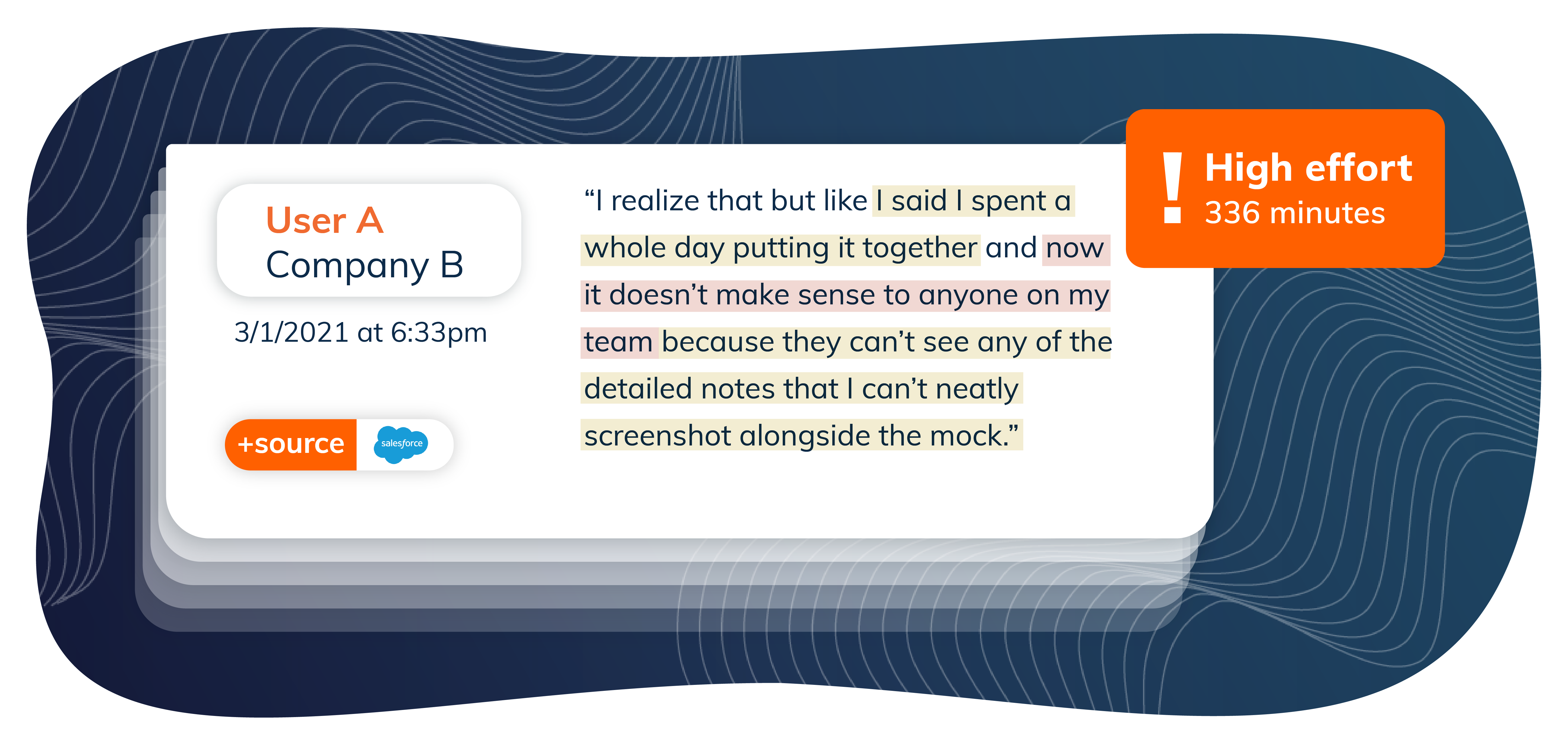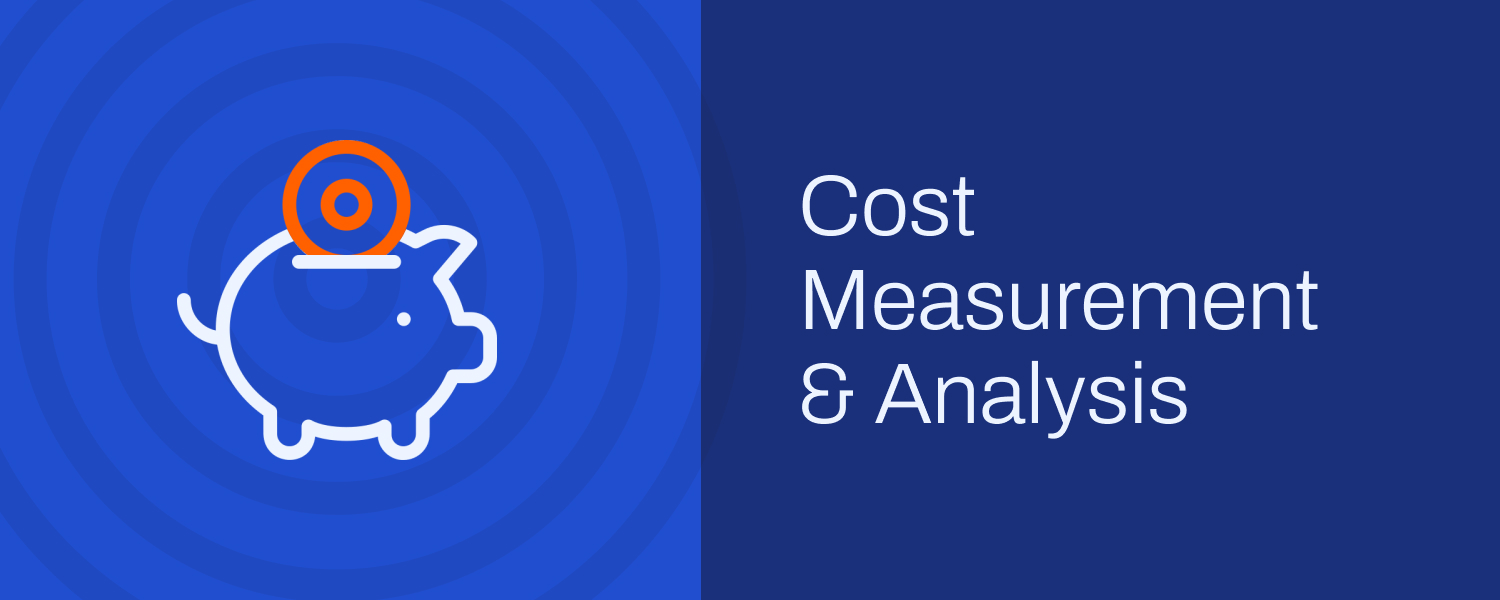We recently discussed why high-impact CX needs high-impact measurement that clearly supports CX goals. This post focuses on measuring customer effort.
Why Measure Customer Effort?
Customer effort has a direct impact on several business outcomes. Reduced customer effort can decrease operational costs — according to Gartner, a low-effort interaction costs 37% less than a high-effort interaction. Furthermore, low-effort experiences reduce costs by decreasing up to 40% of repeat calls, 50% of escalations, and 54% of channel switching. Reducing customer effort can also increase customer retention — 96% of customers who exert high effort are likely to churn, vs. only 9% of those who enjoyed effortless experiences.
To identify friction in your customer experience, you need early warning signs that tell you when, where, and why customer effort is spiking. To address friction, you need to test hypotheses about how you can reduce customer effort. And to tie those customer effort-reducing activities to business outcomes, your effort metrics need to reliably predict the customer behaviors you want to encourage and avoid.
Surveying ≠ Measuring Customer Effort
A popular way to measure effort is with a Customer Effort Score (“CES”) survey that asks customers to rate how easy or difficult it was to resolve an issue or accomplish a task. However, this approach often fails to help CX teams achieve their goals.
Imagine you’re trying to redeem hard-earned credit card points. But the bank changed their points redemption rules and they’re confusing. You chat with Support to clarify your options and try again, now knowing that different transactions have different point values. You proceed to select transactions and redeem points, but the redeemed value is lower than the points value you saw in your dashboard, and the app won’t let you select more transactions. What gives? You chat with Support again, and they confirm that you have redeemed all of your available points — it turns out you could have redeemed an extra $200 worth had you selected older transactions instead of recent ones?!
The chat concludes with a “How easy was it for you to handle your issue?” survey. Skip. You’ve already spent 45 minutes on something that used to be easy, your issue wasn’t handled, and it cost you $200 because the new rules aren’t clear.
The bank’s goal is to build high lifetime value relationships with customers and ensure you remain an active customer. But because you didn’t answer the effort survey, they have no reason to believe that, in the future, you’ll be making bigger-ticket purchases on another card.
The problem is that the bank is working with faulty data that they can’t directly tie to business outcomes. There are likely to be many more customers like you that are frustrated with the new reward points redemption process and skipped the survey. But the bank has no data to describe this faction of their customer base, quantify the problem, and set goals to improve the experience for you and your old point system-loving cohort.
The bank also seeks to reduce friction and identify early warning signs of breakdowns in your experience. Unfortunately, by surveying effort, the bank missed out on the “early” part of early warning signs and missed a chance to course-correct your experience.
By the time companies survey effort, they have lost their chance to get ahead of it, and the damage is done. Your interactions with the bank’s Support team provided some early warning signals — but they failed to capture and respond to your experience.
Lastly, but certainly not least, the bank wants to test hypotheses to help them understand what they need to improve. But how will they know to focus on improving the reward points redemption process if they don’t even know that it’s a big contributor to customer effort? Learning that reward points redemption is a rough edge in their customer experience can inspire them to try things like listing transactions according to point value instead of recency or bring back some simpler elements of the old version.
Measure Effort on Your Customers’ Terms
Surveying customer effort at the end of an experience reflects your business’s process, not your customers’.
Whether you’re a bank or a SaaS company, it’s critical to understand and measure customer effort the way that your customers experience it. Organic customer feedback is the currency of your customer journey and the key to measuring customer effort. Mining organic customer feedback with Natural Language Understanding (“NLU”) technology and analyzing surrounding timing patterns is how you figure out what’s driving effort, for _ whom_ , when , for how long , and why , so you can take action to address it.
Grounding effort measurement in a high volume of organic customer feedback means it’s easy to tie different effort expressions to the behaviors you want to encourage and avoid. Once you know which kinds of customer efforts correlate with specific behaviors, you can prioritize reducing effort behind the behaviors that significantly impact your customer relationships and your business.
Let’s say you work for a company that offers design tools. Analyzing your organic customer feedback from channels like support and your user community could reveal that exporting mock-ups to share with other team members is a leading cause of customer effort. There were over 200 related support cases about it this month and over 120 related threads in your user forum where customers discuss easier ways to share mock-ups interactively. You review the themes and double-click on the underlying organic verbatims. Your takeaway: When customers invite their team to view their work, you force them through an onboarding process. It takes too much time — all they want to do at that moment is provide quick feedback to their team. So they don’t log into the tool and engage with the design. Your customer now has to take cumbersome screenshots of every mock-up that their co-workers can’t comment on or manipulate directly.
Your takeaway: When customers invite their team to view their work, you force them through an onboarding process. It takes too much time — all they want to do at that moment is provide quick feedback to their team. So they don’t log into the tool and engage with the design. Your customer now has to take cumbersome screenshots of every mock-up that their co-workers can’t comment on or manipulate directly.
In summary, you’ve identified a specific type of effort that threatens a business outcome you and your customer care about — growing customer user counts. Leveraging a feedback intelligence tool, you can find several examples of this effort unfolding in context, quantify the impact, and set goals to reduce it.
When you measure effort to surface early warning signs, you need to make sure you don’t miss anything important. Measuring organic customer feedback can help you surface and track high-effort interactions and provide appropriate resources to mitigate before they spiral into relationship risks.
Suppose a new customer contacts you for help exporting a mock-up — this interaction screams high effort. Knowing what we know about how much frustration this issue causes customers, it’s important to address it right away. Since you’ve seen this movie before, you might want to bring out the kid gloves to ensure you handle the issue as smoothly as possible until a new export solution is in place.

But the effort surveys most CX teams use for measuring customer effort wouldn’t flag this early warning until it’s too late, if at all.
When you’re measuring effort to test hypotheses about how to improve, you need to understand what’s driving effort so that you can identify your next best actions and set goals. You know that sharing mock-ups with co-workers is a leading cause of customer effort. So you might try delaying the onboarding prompts until team members have engaged with the mock-ups or prioritize building a simple export function with a commenting capability to solve the problem.

Once you know the source of the effort, this is a great opportunity to use surveys. You might want to deploy targeted surveys to customers who have experienced that effort and want to weigh in on the ideal solution.
Customers leave a rich trail of organic feedback full of effort signals that CX teams need to capture in measuring effort. Customer effort measurement needs to reflect the signals that your customers use to express effort, like language and the length and timing of interactions. Effective customer effort measurement means you can use it to prioritize product, service, and operational improvements. And most importantly, to proactively identify and remove friction from your customer experience and connect your hard work to business outcomes.
For more on our approach to measuring customer effort, check out our infographic with 5 Benefits of the AI-Driven Customer Effort Score.


